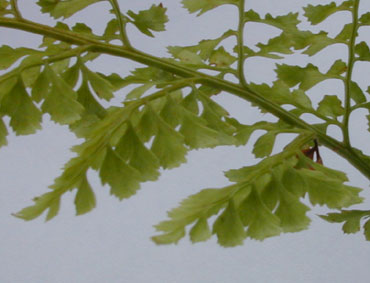|
Hardy Fern Home A. standishii resources
All Ferns � Dryopteridaceae �� Arachniodes
�Other Genera
|
| Arachniodes standishii | ||
Upside-down fern | ||
|
Etymology
Perhaps for John Standish (1814-1875) a nurseryman of Ascot in Berkshire, England who imported from Japan.
Description
Rhizome: short-creeping, scaly.
Frond: 100 cm high by 30 cm wide, evergreen, monomorphic, blade/stipe ratio: 2:1. Stipe: straw-colored, dark at base, scales on stipes pale brown, larger ones to 2 cm long, linear-lanceolate and very dense on lower portion, vascular bundles: 4 or more in an arc. Blade: 3-pinnate, oblong-lanceolate, soft, dull green, papery, scales on lower surface of veins linear, 0.5--1 mm long. Pinnae: 15 to 25 pair, oblong, moderately acute; pinnules broadly oblong, acute at apex, sessile or very short-stalked; costae grooved above, continuous from rachis to costae to costules; margins toothed; veins free, forked, barely visible. Sori: round, near the midrib, indusium: reniform, tan, attached at a sinus, sporangia: black. Culture
Habitat: on moist ground in mountain forests, common in Cryptomeria forests.
Distribution: Japan, Korea.
Hardy to -30�C, USDA Zone 4, but Zone 6 also reported.
Synonyms
Polystichum standishii (T. Moore) C. Christensen Lastrea standishii T. Moore Rumohra standishii (T. Moore) Ching |
|
|
Notes
Upside-down The books give various reasons for the name: 1) the veins are prominent on the upper frond surface rather than the more common lower surface, or 2) the upward-pointing first pinnule on the lowest pinnae is larger than the first downward-pointing one, a reversal of usual differences - not true on my one specimen, or 3) the dense, black sporangia are visible from the upper surface. Take your pick. I favor the statement�accompanying the photo below.
Upside-down The books give various reasons for the name: 1) the veins are prominent on the upper frond surface rather than the more common lower surface, or 2) the upward-pointing first pinnule on the lowest pinnae is larger than the first downward-pointing one, a reversal of usual differences - not true on my one specimen, or 3) the dense, black sporangia are visible from the upper surface. Take your pick. I favor the statement�accompanying the photo below.

Arachniodes standishii. The pinnules bend down, giving the impression the camera is looking up rather than down from above. �Photo: Tom Stuart |